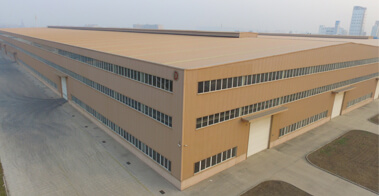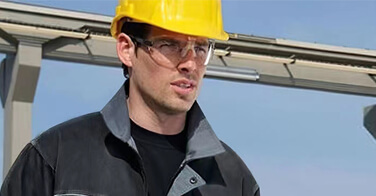LNG ambient air vaporizer is a device used to vaporize liquefied natural gas (LNG) into natural gas by using ambient air as the heat source. The vaporizer consists of a series of coils or plates that contain the LNG and are exposed to the surrounding air. As the LNG flows through the coils or plates, heat from the ambient air is transferred to the LNG, causing it to vaporize and convert into natural gas.
The LNG ambient vaporizer is a new natural gas supply process that consists of LNG low-temperature steel cylinders, ambient vaporizer, and pressure regulating metering system. The LNG cylinder group vaporization station is designed for use by 1,000-5,000 households and has the advantages of small investment, short construction time, and low operating costs when located within a 300-kilometer range of an LNG storage tank. It can fill low-temperature steel cylinders and has low operating costs.
LNG ambient air vaporizers are commonly used in natural gas processing plants, industrial applications, and in the transportation of LNG by truck, rail or ship. They are preferred over other types of vaporizers because they do not require an external heat source or a power supply, making them more energy-efficient and cost-effective. Additionally, they are simple to install and maintain, and can be easily integrated into existing gas processing facilities.
Working Principle:
The LNG air-temperature vaporizer uses natural convection of air to heat the low-temperature liquid in the heat exchange tube, fully evaporating it into gas. It is a high-efficiency and energy-saving heat exchange equipment that combines air-temperature and heating vaporization functions and can replace heating vaporization products. Vaporizers are used to vaporize low-temperature liquefied gas through heat exchange into a gas of a certain temperature, and are classified into high, medium, and low-pressure types according to their use.
The high-pressure vaporizer pressurizes liquefied oxygen, nitrogen, argon, and liquefied natural gas after being pumped at low temperature, and then fills high-pressure gas into steel cylinders. The low-pressure vaporizer vaporizes the low-temperature liquid in the storage tank into low-pressure gas, which is then transported to the usage site through a pressure regulation device and pipeline. Compared with water-bath electric heating vaporizers and steam-heated water-bath vaporizers, air-temperature vaporizers are highly efficient and energy-saving, saving a large amount of electricity or steam.
The structural characteristics of the vaporizer can ensure normal operation of all components at deep-cold temperatures, avoid seal freezing, have good sealing performance, are safe and reliable, non-corrosive, and have a long service life. The use of special φ120, φ160, and φ200 large-diameter aluminum finned tubes ensures extremely fast defrosting speed. The welds at all component connections of the vaporizer are welded by argon arc welding, with neat and beautiful welds and no porosity defects. The optimized process design reduces pressure drop to a low level, eliminates biased flow, and ensures that the flow rate is controlled within a safe range.
Structural Characteristics:
The series of vaporizers are constructed using a tube-and-fin design, with a "bridge" style connection formed by connecting star-shaped fins to improve vaporization capacity and equipment flexibility. The fins are connected without welding, resulting in low internal stress and a compact, even, and durable structure.
The heat transfer tube of the ambient vaporizer is made by extruding the heat sink and tube material into a star-shaped fin cross-section. The ambient vaporizer consists of an evaporation section and a heating section. The evaporation section is composed of heat transfer tubes connected by end plate tubes in parallel, while the heating section is composed of heat transfer tubes connected in series by bending joints.
Star-shaped finned tube is the core component of the vaporizer and the main player in heat absorption and vaporization. The material of the finned tube is rust-resistant aluminum, and the fins of the finned tube are commonly available in 8mm and 12mm. The outer diameter of the finned tube mainly has two specifications: φ160mm and φ200mm, with larger vaporizers typically using φ200mm.
All parts are made of high-quality aluminum alloy and stainless steel with excellent anti-corrosion properties. The stainless steel core tube is tightly connected to the fins. Before leaving the factory, they are dried with nitrogen according to oxygen standards to ensure product quality and safety during use.
Main Technical Parameters:
-
Operating pressure: 0.1-40 MPa
-
Applicable media: LO2, LN2, LAr, LNG, LCO2, LC2H4, LPG, LNH3, LC3H8, etc.
-
Single unit vaporization capacity: 20-10,000 Nm3/h (larger vaporization capacity can be achieved by combining multiple units)
-
Various specifications of boosters and heaters can be produced according to user requirements.
Note: For larger flow rates and longer continuous full-load operation, multiple units can be connected in parallel or switched. Design conditions: Temperature -10°C, relative humidity 70%, continuous vaporization capacity for 8-12 hours.
Main Advantages:
-
The use of large aluminum finned heat exchange tubes with high heat exchange coefficient, good strength and flexibility, and fast defrosting speed, ensuring efficient heat exchange and low weight.
-
The equipment is connected by aluminum profiles in a "bridge" style, which is aesthetically pleasing, sturdy, and durable, effectively eliminating the stress caused by thermal expansion and contraction.
-
Through optimization design and practical experience, the vaporizer meets the requirements of gasification, cost savings, pressure drop reduction, and no bias flow.
-
The equipment is simple, compact, quick to install, easy to maintain, and operate.
-
There are no moving parts or easily damaged and consumable parts in the equipment. It does not require any energy to operate, has no operating costs, and is environmentally friendly.
-
The heat exchange tube surface is treated with anti-oxidation, with a long service life and a one-time investment for lifelong use.
-
There are multiple specifications of heat exchange tubes to choose from, and the external dimensions can be designed according to requirements to reduce the area occupied and save space.
-
Advanced high-pressure pipe composite technology ensures the contact between the pressure pipe and the heat exchange pipe, ensuring effective heat exchange.
-
All equipment parts are cleaned and manufactured according to oxygen service standards, ensuring safe use.







